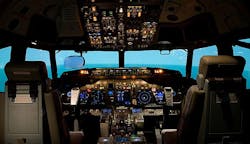Boeing to provide flight training and weapons tactics simulators for P-8A crews
Officials of the U.S. Naval Air Warfare Center Training Systems Division in Orlando, Fla., announced a $118 million contract modification Monday to the Boeing Defense, Space & Security segment in St. Louis to provide P-8A flight simulators for the U.S. Navy and for the government of Australia.
The simulation and training equipment will be installed at Whidbey Island Naval Air Station in Oak Harbor, Wash., which is the primary P-8A base on the West Coast.
Navy leaders plan to replace the nation's fleet of P-3 turboprop maritime patrol and anti-submarine warfare (ASW) aircraft with the new Boeing P-8. Four P-3 squadrons today are based at Whidbey Island, which were moved to that base after the Navy closed Moffett Field Naval Air Station in Mountain View, Calif., in 1994.
Related: Boeing to provide Navy P-8A Poseidon patrol jet flight simulators in $225 million contract
Moffett Field had been the Navy's principal West Coast P-3 base. The nation's other aircraft base with a major presence of the P-8 Poseidon is Jacksonville NAS in Jacksonville, Fla.
This contract modification calls for Boeing to build and install two operational flight trainers (OFTs), two weapons tactics trainers (WTTs), and upgrades to the existing training system support center (TSSC) for the Navy. Boeing is the prime contractor for the P-8A aircraft.
In addition, Boeing will install two OFTs, two WTTs, one part task trainer, and one TSSC; the procurement and installation of six electronic classrooms, 26 mission station desktop trainers, and 32 flight mission system trainers.
The company also will provide P-8A courseware, training, and interim support for the Royal Australian Air Force.
Related: Boeing to provide Apache Longbow simulation and training systems in $14.4 million contract
An operational fight trainer is a general flight training simulator without specialist tactics and weapons training. The OFT typically has a motion platform for realistic instrument flying and other procedural training.
A weapons tactics trainer enables flight crews to receive realistic training in employing the aircraft's weapons, such as sonobuoys, unmanned aerial vehicles (UAVs), and air-launch torpedoes, as well as training for detecting, locating, and attacking enemy submarines.
Boeing will do the work at Whidbey Island Naval Air Station, Wash.; St. Louis; and Edinburgh, Australia, and should be finished by June 2019.
For more information contact Boeing Defense, Space & Security online at www.boeing.com/defense, or the Naval Air Warfare Center Training Systems Division-Orlando at www.navair.navy.mil/nawctsd.
About the Author
John Keller
Editor-in-Chief
John Keller is the Editor-in-Chief, Military & Aerospace Electronics Magazine--provides extensive coverage and analysis of enabling electronics and optoelectronic technologies in military, space and commercial aviation applications. John has been a member of the Military & Aerospace Electronics staff since 1989 and chief editor since 1995.
